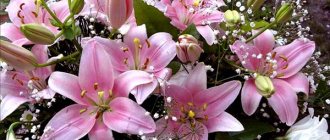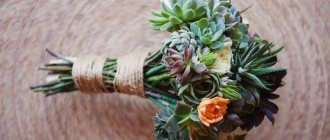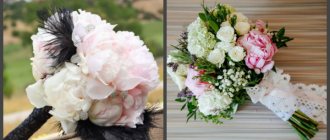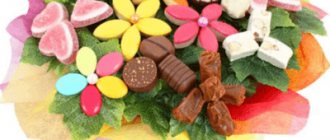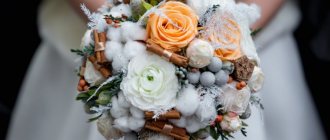The word “ranunculus” is somewhat unusual for Russian girls. Although in Western countries (England, France, Italy) everyone knows it. And the reason is in terminology. The Russian name for ranunculus is “garden buttercup”. Think you've never seen either one? Take a closer look at the flower trays and bridal bouquets - you will find ranunculus in abundance there. Outwardly, they are very reminiscent of roses or peonies, so people unfamiliar with floristry can easily confuse them.
Symbolism and legends
The ancient Slavs associated ranunculus with Perun, the warlike god. The flower meant power, authority. But in a wedding bouquet, the buttercup symbolizes the submission of passions, humility to one’s own will and the will of the chosen one. To emphasize the meaning, girls choose white or delicate, pastel shades of buds. To enhance harmony, use different bright tones:
- purple;
- red;
- burgundy;
- yellow;
- orange.
There are legends about this plant. The Persians told about a young prince who fell in love with a nymph. All day long he sang songs to her. In the first version of the legend, the nymphs, in the company of their beloved, who did not reciprocate his feelings, were tired of listening to the young man. In a fit of anger due to importunity, he was turned into a ranunculus. In the second, the prince himself died from the grief of unrequited feelings, becoming a buttercup after death.
Coyote missed the Indian legend. Out of idleness, he threw his eyes into the air and caught them. In one of the throws they were caught by an eagle. Coyote made new eyes from buttercup buds.
Europeans had such a legend. One girl wanted to marry the man she loved. Her father forbade her to even see him. The girl was from a rich family, with a long pedigree, and her lover was a poor man without a name or regalia. The father did not approve of his daughter's feelings because of his stinginess. Then the girl, out of grief, scattered all her father’s savings. After some time, buttercups grew in place of the coins. Since then, people have believed that a randomly found ranunculus bud brings wealth. Superstitious people even plant buttercups in their gardens, hoping that this will help them get rich.
Ranunculus was a symbol of the power and greatness of the Ottoman Empire. On the ornaments, its buds were depicted at the same time as peas.
Mention of buttercup is found in the works of classics. Shakespeare, in his play about Romeo and Juliet, described a situation where a drink was brewed from this plant, which put the girl to sleep.
Christians believe that Jesus Christ turned the stars in the sky into ranunculus buds and gave them to the Virgin Mary as a sign of deep respect and love. Since then, during Holy Week, people present golden buds of buttercups to the Virgin Mary.
History of the plant
The homeland of ranunculus is Asia Minor. Translated from Latin - “frog”. The name is given based on the flower’s growing environment; it was more often found in swampy areas.
In the 16th century, the flower was brought to England. Flower growers liked the plant, they began to grow it and use it in bouquets. In the 19th century, the excitement died down, but in the 21st century, florists returned to it again. In Argentina and Holland, vast areas are allocated for growing ranunculus.
In Ancient Rus', ranunculus was called buttercup, because bright yellow, orange, and red colors were considered aggressive and fierce.
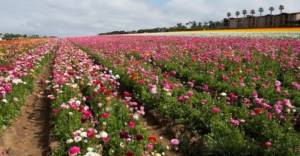
Features of buttercup
The flower is popular in wedding bouquets due to its wide range of colors and different bud sizes. This helps create dense, neat compositions with bright accents or soft gradient transitions.
Buttercups are divided into:
- rose-like - the buds are similar to a rose, but 2-3 times larger;
- peony-like - the petals, like those of peonies, bend inward.
Both types of plants have heavy buds but long, thin stems. To strengthen them, the leg is rewound with tape or wrapped with floral wire.
Ranunculus, grown as cut flowers, is a seasonal flower. Summer is the only time when you can’t buy it in a flower shop. Therefore, brides planning a wedding from October to May can make a bouquet with ranunculus, but in the summer they will have to replace it with another plant.
Benefits of ranunculus:
- A hardy plant that lasts in a vase for two weeks. You can safely use buttercups for wedding events. Even though the flower grows in damp places, it will last the entire celebration without water, without losing its natural freshness.
- Ranunculus smell nice, the light scent goes with any bride's perfume, and will not draw attention to itself.
- Suppliers have a huge selection of different colors, sizes and shapes of buds. You can use lush and thick or neat and miniature. The only shade that does not exist in its pure form is blue.
- Buttercups are collected in a monobouquet or combined with other plants. The composition of the composition depends only on the wishes of the bride.
Flaws:
- Unavailability of the plant in the summer season.
- High price.
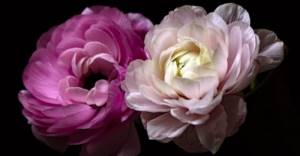
Features of ranunculus
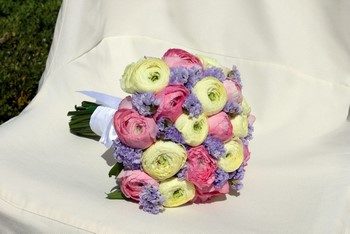
Ranunculus are lush and large buds that have many petals at their base.
In the world of florists, it is customary to divide such flowers into several types:
- Peony plants - such flowers are very similar in appearance to peonies, that is, they have lush buds, a numerous number of petals and a rich aroma.
- Rose-shaped plants - in appearance they very much resemble a medium-sized rose.
All types of ranunculus consist of a voluminous bud and a long stem. At the base, florists tie ranunculi with wire or thick thread or rope.
The disadvantage of such flower plants is their seasonality. They are available only from late autumn to late spring. But in the summer, to the surprise of many, such flowers cannot be found on sale at all. This creates many problems when brides want such a flower arrangement for themselves in the summer.
However, on the other hand, winter brides will be able to please themselves with a truly juicy and warm spring bouquet, which is sometimes so lacking at celebrations in the cold season.
Surprisingly, ranunculus can survive in water for up to one month. To do this, you just need to carefully cut it off and change the water periodically. Even autumn flowers, which are valued for this very reason, can envy such durability. Florists and breeders still have not found an explanation for the fact that the flower grew in a humid climate, but has perfectly adapted to dry conditions.
The undeniable advantages of garden buttercup are:
- variety of color combinations;
- a large number of shapes and sizes;
- pleasant and unobtrusive smell;
- original appearance.
In fact, as for the last point, it can even be put in first place. Only a small number of brides choose this plant format. Often it comes down to price, because it is expensive, so not everyone decides to buy it.
But in this matter it is worth thinking about the so-called savings. You can always buy a bouquet of cheap flowers that will wither by the evening, or give preference to ranunculus, which will delight the newlyweds for another month from the wedding day.
Care Tips
To save the life of garden buttercups, consider the following rules:
- long periods without water discolor the buds;
- in film packaging, the stems begin to rot quickly;
- It is better to trim stems in water;
- cleanliness of the container where ranunculi are placed is the key to long life;
- fertilizing for cut flowers will preserve the color of the foliage and prevent yellowing of the buds;
- buds continue to grow after cutting, which leads to sagging of the bud;
- the water container is constantly renewed by adding new water, buttercups drink a lot;
- A sign of the freshness of a garden buttercup is that it closes its petals at night.
Varieties of buttercups for the bride's bouquet
In Russia, ranunculi came from Asia Minor and Europe. About five thousand different types of buttercups are grown, but not all are suitable for assembling bouquets. In Russia, compositions use two varieties of plants:
- "Elegance";
- "Queenie."
The buds of the "Elegance" variety are smaller in size. Small, neat bouquets are collected from them. Flowers individually are not so presentable, but in a composition they look elegant. Ranunculus "Elegance" are often collected in bouquets of the classic shape - a hemisphere.
The Queenie variety is distinguished by lush buds with a large number of petals. Large structures are assembled from them and combined with succulents, greenery and other flowers. Buttercups look perfect in tousled arrangements.
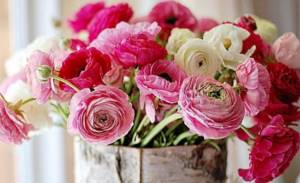
Wedding bouquet of the bride from ranunculus (photo)

A wedding is a crucial moment in the life of the bride, first of all, so planning and preparing for this celebration takes a lot of time and effort. It is impossible to imagine a wedding in the decoration of which flowers would not be present: from the bride’s bouquet to the boutonnieres of the groom and witnesses. The choice of flowers depends on the style of the wedding, color scheme, personal preferences or the season. Among the larger selection of flowers, ranunculus occupy a leading place in wedding decorations among brides. These flowers are known to us under the popular name of garden buttercups; the ranunculus season begins from October-November to April-May. The advantage of these colors was the color palette and a significant number of combination options. Outwardly, they resemble roses, with the same lush and voluminous buds, but they are distinguished by their aristocracy and elegance. Buttercups will be the basis of a wedding bouquet or an addition.
Ranunculus variety
This type of flowers, which florists like so much, includes 400 species, but in Russia an order of magnitude less is already known, let’s take a closer look and take a closer look at some of them.
Pecotee
This type of buttercup vaguely resembles a peony bud, the same in terms of shape and splendor. Noteworthy is the contrasting color of the edges relative to the main color. It may have a rich burgundy edge and a predominant soft pink petal.
Elegance
It is this ranunculus flower that has a rich coloring; there are single-color buds with stroke-edges of a different color. Wedding decorations and details made from this type of buttercup look interesting and unexpected.
Pon-pon
This flower fully lives up to its name, because the bud really looks like a pompom - lush, juicy and noticeable. This is a mix of pale pink, shades of red and green. The petals are located very close to each other.
Festival
A variety of buttercups that is rightfully considered the brightest and freshest. A distinctive feature of this species is the unchanged green core and contrasting petals (can be any: yellow, white or pink). The shape of the petals is also partially changed - they are pointed at the tips.
Ranunculus goes well with:
- Peonies
- Craspedia
- Peony roses
- Freesia
- Roses
- Anemones
In fact, there are many combination options, choose the one that suits your desires. Let's take a closer look at some of them.
Compositions of ranunculus and freesias
The combination of buttercups and freesias looks unusual in a wedding bouquet. The subtle and aromatic scent and choice of colors create compositions that are pleasing to the eye. You can complement such a bouquet with green branches - aspidistra foliage or monstera.
Wedding bouquet of ranunculus and roses
This combination turns out to be gentle and neat; a wedding bouquet of these flowers emphasizes the beauty of the bride’s dress. You can dilute the tenderness with foliage of decorative greenery, or you can leave it unchanged.
Anemone and ranunculus compositions
Anemone is a quivering plant with fragile and sensitive petals. The combination with buttercup looks impressive, because the coloring of the petals is represented by bright and rich colors. If you decide to add rainbow colors to your wedding, then anemone is a great option.
Ranunculus will become the basis for the design of your wedding; they are present in the bride’s bouquet or hairstyle, the groom’s boutonniere, the design of a wedding arch or wall, and the decoration of the festive table.
Which brides are suitable
Ranunculus in a wedding bouquet mean humility of passions; it is chosen by strong-willed, self-sufficient girls. With a bouquet in their hands, such brides look sophisticated, calm, flexible, but inside there is a fire burning that does not allow them to put up with what they don’t like.
The behavior inherent in a true lady charms those around her. Intelligence, prudence, and determination help you choose a reliable life partner. Therefore, you don’t have to worry about such a girl: she will make the right decision in any life situation. Buttercups are perfect for this character type. Delicate pastel shades are chosen by young girls, and deep bright flowers are chosen by older women.
On a note! Do not leave the bouquet in a draft or direct sunlight. Just a rule will extend the life of flowers.
Which bride would suit a bouquet of ranunculus?
Ranunculus are the choice of women who are outwardly modest and sophisticated, but with raging hurricanes inside. Like this flower, they charm with their manners, behavior and sharp mind, but inside they are self-sufficient, calculating and immensely persistent. The one to whom you gave your heart is truly the best of the best, since he deserves the honor of being next to such a wayward, albeit outwardly docile, lady.
Flowers in light colors, as well as those colored along the edges of the petals, are suitable for young girls; richer and deeper colors are suitable for adult women.
Combination with other plants
A monobouquet of ranunculus looks original and harmonious. You can use flowers of the same or different shades. For a complete composition, 5-7 lush buds are enough. This bouquet looks aristocratic and rich. To add individuality to the composition, add gypsophyll, lilies of the valley or greens with medium-sized leaves. The design of several types of flower plants reflects luxury and presentability. For a composition with garden buttercups choose:
- Roses. The plant buds are very similar in appearance. Thanks to this, bright, picturesque bouquets are formed. Flowers of the same shades are not used in the bride’s bouquet; with such an arrangement, both types of plants are lost. A composition of white ranunculus and light pink roses is a good idea. Experimenting with shades in a bouquet of ranunculus and roses is encouraged.
- Freesia. The combination looks original in warm pastel shades. To make the composition brighter, you can add buttercups with colorful petal edges. Such a delicate composition will add sophistication and sophistication to the girl’s image.
- Peonies. Peony buds are not much different from buttercups. This allows you to create different variations of bouquets. Only an experienced florist notices the obvious difference between flowers. A composition of two plants becomes the highlight of the girl’s image.
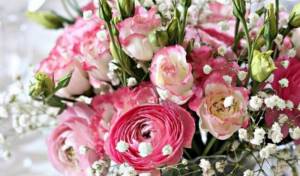
In addition to the most common combination options, buttercups are suitable for:
- succulents;
- amaryllis;
- chrysanthemums;
- anemones;
- craspedia;
- hydrangeas;
- calla lilies
Layout examples
Buttercups are especially good because they have lush inflorescences at the base. Accordingly, in order to make a truly lush composition you will need at least 5 buds. Additional plants can be added to them. They can either complement or shade the main flower.
Don't forget to use greens too. It helps to bring a special naturalness and naturalness to the bouquet.
Any flowers with small petals or inflorescences will help create the necessary contrast in the image. On the one hand, in front of you will be large buds of peonies, and on the other hand, they will be shaded by delicate lilies of the valley or violets.
As for the shape of the bouquet itself, you should pay attention either to the hemisphere, which is considered classic, or to the bunch. In the first case, you will get a simple and stylish composition. The second option is suitable for themed wedding ceremonies in a rustic or boho style.
Suitable bouquet shapes
Bouquets of classic hemispherical shapes are collected from ranunculi. Lush buds allow you to do this with a minimum number of plants. An asymmetrical composition with protruding branches of greenery or small flowers looks original.
Brides sometimes choose a non-standard bouquet shape - a heart. The composition has only one drawback: you will have to collect a bouquet only from garden buttercups. Can be diluted by adding small greenery or medium-sized flowers. Ranunculi in a basket look graceful and sophisticated. It is decorated with ribbons or entwined with climbing greenery.
Extravagant girls prefer a composition in the form of a small handbag. This composition will not last more than 5-7 days, because the flowers, although hardy, require moisture. Only floral foam piaflor can help with this version of the bouquet, if you can add it unnoticed to the design.
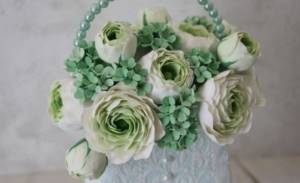
Master class on how to assemble a bouquet of ranunculus
To make a bridal bouquet from garden buttercups, you need to take:
- white ranunculus with small buds;
- greenery;
- floral tape;
- decorative pins with beads;
- white decorative satin ribbon;
- pruner;
- scissors.
Instructions on how to assemble a wedding bouquet with photos:
- We clear the ranunculus stems from leaves. Using pruning shears, we cut off the shoots close to the stem so that they do not get out of the composition.
- We begin to collect, placing the buds close to each other. We form a hemispherical composition.
- When the bouquet is assembled, we take sprigs of greenery and place them along the edges of the composition, hiding the stems of the buttercups.
- Unwind a piece of floral adhesive tape. We fasten the flower stems from the top to the middle of the stem of the bouquet.
- We take a decorative satin ribbon and wrap it around the stems, masking the fastening tape.
- We fix the decorative tape with pins, pointing them upward. This method will protect the bride’s hands from accidental injury.
- Trim off the excess length of the stems. We cut at an acute angle so that the flower has maximum moisture-absorbing surface area.

How to choose a winter bridal bouquet?
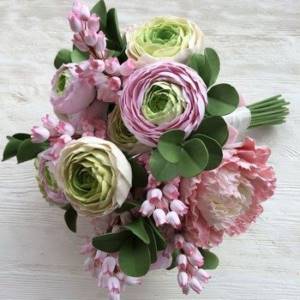
In order to finally decide what the final version of your bouquet will look like, it is worth deciding what type of plant will be and what color you will choose for this.
It is customary to distinguish in floristic terminology the varieties of buttercups Elegance and Cluny:
- Elegance has an elegant and neat appearance, it is not large in size. Despite this, the variety consists of a lush bud and a long stem. It is believed that this variety can be used to create an elegant and at the same time simple composition.
- The Clooney variety looks a little different. The flower, on the contrary, seems to be deliberately large. It is based on so many petals that sometimes it seems as if the stem itself cannot withstand such weight.
Surprisingly, buttercups can come in a variety of different and bizarre colors. This is why they are loved in the winter season. They resemble peonies, which are associated with warm autumn or early spring. A bride's bouquet of ranunculus will add special warmth to the image.
There are only blue ranunculus in the world. The rest of all color variations are available to modern brides.

